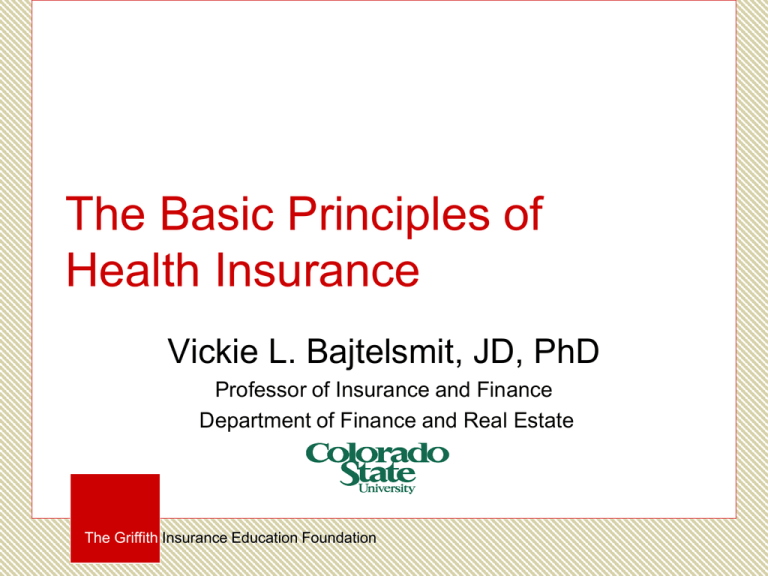The Basic Principles of Risk Management and Insurance
advertisement

The Basic Principles of Health Insurance Vickie L. Bajtelsmit, JD, PhD Professor of Insurance and Finance Department of Finance and Real Estate The Griffith Insurance Education Foundation Agenda Trends in employee benefits Problems in the health care/health insurance market Types of health insurance coverage Patient Protection and Affordable Care Act (PPACA) The Griffith Insurance Education Foundation Why Do Firms Offer Employee Benefits? Tax advantages of qualified plans Cost savings of group insurance Competition for qualified workers Improved employee productivity, morale and retention The Griffith Insurance Education Foundation Tax Benefits of Qualified Plans Employee benefits are not taxable income to employee and are a deductible business expense to the employer. How much does this save? Federal (25%), state (5%), and payroll taxes (7.65%) ~38% If health insurance is $6,000, employee would need $9,677 in pre-tax income to buy on his/her own. =cost/(1-t) The Griffith Insurance Education Foundation What are the benefits of getting health insurance through employers? Group insurance usually cheaper. Lower underwriting costs Lower administrative costs (e.g. billing) No individual negotiation or commissions When insurance is offered to a group, all members are eligible to participate without proof of insurability Employees may prefer the simplicity The Griffith Insurance Education Foundation Benefits Offered by Small vs Med/Lg Firms Type of Employee Benefit Insurance Health Prescription Drugs Dental Vision Life Long Term Care Health Savings Accounts Disability Paid sick leave Short term Long term Retirement Any Defined Benefit Defined Contribution Small Firms (Less than 100 workers) 42% 40% 23% 13% 40% 6% 8% 53% 26% 20% 35% 9% 31% Medium/Large Firms (100+ Employees) 63% 61% 51% 28% 75% 24% 21% 73% 52% 44% 66% 30% 54% Type of Employee Benefit Paid Time Off Holidays Vacation Personal leave Family leave Unpaid Time Off Family leave Other Benefits-Financial Reimb. Acct: Childcare Reimb. Acct: Healthcare Severance pay Other Benefits-Quality of Life Child care Subsidized Commuting Wellness programs Emplee Assistance Programs Source: U.S. Department of Labor, Bureau of Labor Statistics www.bls.gov The Griffith Insurance Education Foundation Small Firms (Less than 100 workers) Medium/Large Firms (100+ Employees) 70% 70% 26% 7% 87% 85% 50% 13% 77% 94% 20% 19% 51% 53% 4% 3% 14% 25% 16% 9% 50% 69% Benefits Differ by Firm Characteristics The Griffith Insurance Education Foundation Trends in Retirement Plan Types (All Workers) The Griffith Insurance Education Foundation Trends in Retirement Plan Types (Among Workers Who Have a Plan) The Griffith Insurance Education Foundation Role of ERISA – Employee Retirement Income Security Act Established federal standards for employee benefits, including retirement and health plans and prohibits states from regulating such plans The preemption clause states that ERISA supersedes all state laws relating to employee benefit plans as defined under ERISA One such exemption is for state laws regulating insurance The Griffith Insurance Education Foundation Issues in Health Insurance and Healthcare Health care cost inflation More than double CPI Health expenditures as % of GDP (~14%) Per capita expenditures increase at 6%, premiums average 7% of disposable income Quality relative to cost Aging of the population Will increase demand for care and costs Reduced employer coverage of retiree health ins. Pre-PPACA, uninsured 16% of the population The Griffith Insurance Education Foundation Average Annual Premiums for Single and Family Coverage, 1999-2011 The Griffith Insurance Education Foundation Firm and Worker Premium Contributions for Single and Family Coverage, by Plan Type, 2011 The Griffith Insurance Education Foundation Sources: Kaiser Family Foundation Survey of Employer Sponsored Health Benefits Increases in Workers’ Contributions to Premiums, Inflation, and Earnings, 1999-2011 The Griffith Insurance Education Foundation Rate of Increase is Slowing 16.0 Family Premium (Small Firm) Annual % Increase 14.0 Family Premium (Large Firm) 12.0 Overall Inflation 10.0 Wage Growth 8.0 6.0 4.0 2.0 0.0 -2.0 2000 2001 2002 2003 2004 2005 2006 2007 2008 2009 2010 2011 Since 2000, cumulative increases in: prices (34%) wages (47%) family health premiums (250%) The Griffith Insurance Education Foundation Sources: Kaiser Family Foundation Survey of Employer Sponsored Health Benefits; Bureau of Labor Statistics, 20002010 Types of Health Insurance Coverage Traditional fee-for-service (FFS) Reimburses for actual medical costs incurred Patient decides what medical care they want Managed care Costs are reduced by: Controlling patient access to medical care Contracting with providers for lower rates Providing incentives for low-cost alternatives The Griffith Insurance Education Foundation Traditional Indemnity Plans (Fee-For-Service) Basic and major medical Provider usually bills insurance company Choice of providers Deductibles, Coinsurance (e.g. 80/20), and out of pocket limits (stop-loss) Common exclusions: well care, cosmetic, vision, dental The Griffith Insurance Education Foundation Problems with Indemnity Plans Consumers have no incentive to control costs Don’t pay directly for services, so incentive to use more once the deductible is met Cost comparison info isn’t readily available Providers have no incentive to control costs More services, more income and profit Classic moral hazard problem Increasing costs over time The Griffith Insurance Education Foundation Methods of Controlling Costs “Self-insurance” Managed care plans Consumer choice plans The Griffith Insurance Education Foundation Self-funded plans Note: Self-insurance is not really insurance; employer takes the risk How can self-funding reduce costs? Avoid state mandates (ERISA preemption) Lower admin. costs and insurer profit charges. Reinsure above a stop-loss (average $200,000) Can provide incentives to employees Percentage of covered workers in partially or fully self-funded plans grew from 44% in 1999 to 60% in 2011 The Griffith Insurance Education Foundation Managed Care Organizations Health Maintenance Organization (HMO) Limited choice ; comprehensive care Providers have incentives to control costs Preferred Provider Organization (PPO) Participating providers contract for reduced $ Point of Service (POS) Similar to PPO, but affiliated with an HMO so more comprehensive medical care The Griffith Insurance Education Foundation Consumer-Driven Plans High deductible health plan with HSA Unused HSA funds can be saved pretax for retirement or future medical costs. Preventive care usually covered Cost sharing incentives Contributory premiums Better coverage for in-network, generic Rx GOALIncentives for cost control The Griffith Insurance Education Foundation Trends in Health Insurance Type The Griffith Insurance Education Foundation Other Sources of Health Insurance Social Security Medicare (age 65+) Part A (hospital); payroll tax (1.45%); no additional premium if 40 quarters (otherwise $248-$451/mo) Part B (medical) $99.90/mo. premium in 2012 (more if MAGI>$85,000) Part D (Rx) (average $30-$40/month 2012) Medicare Supplement (“medigap”) Private plans that fill in Medicare gaps Medicaid (for low income) State-run, federally-subsidized health insurance The Griffith Insurance Education Foundation PPACA Key Provisions Individual Mandate (2014) Must have health insurance or pay tax penalty $695 $2,085 based on income Employer Mandate (2014) Employers of 50+ workers: $2,000 penalty for no health ins. (excluding the first 30 employees)- Medical Loss Ratio 80% of premiums (small group plans 85%) must go to claims costs and quality improvements; rebate the excess to consumers. The Griffith Insurance Education Foundation PPACA Key Provisions State Health Exchanges (2014) Individuals and businesses < 100 employees can purchase certain types of policies Federal support to states for creation of the Exchanges Expansion of Medicaid (2014) Cover < age 65 with AGI up to 133% of poverty level (~$14,000 individual, $29,000 family of 4) Fully funded by federal government first 3 years, 90% thereafter The Griffith Insurance Education Foundation PPACA Key Provisions Premium Subsidies: For incomes up to 400% of poverty level ($44,000 individual, $92,000 family of 4) w/o employer plan Insurance must be bought through Exchange reduce adverse selection concerns Premium Tax Credits (2010) 35% to small businesses providing insurance to employees (increasing to 50% 2014) The Griffith Insurance Education Foundation PPACA Key Provisions Coverage Requirements: Children to age 19 regardless of preex. cond. Children to age 26 on parents plan No annual or lifetime limits on coverage. Must include well care with no copay or deductibles Premiums Limits on plan increases, effect of rating factors, and difference in premiums between highest and lower priced plans Prohibit Rescission for “Honest Mistake” The Griffith Insurance Education Foundation Health Exchange Plans Bronze Plan % of coverage of benefit costs of the plan 60% Silver Plan Gold Plan 70% 80% Platinum Plan 90% Catastrophic Plan Only available in individual market for those up to age 30 or exempt from mandate Out of pocket limit Equal to the Health Savings Account (HSA) limit $6,250 individuals, $12,500 families in 2013 Pricing Factors Age: 3:1 Smoking Status 1.5:1 Area within a state Family composition The Griffith Insurance Education Foundation Questions? The Griffith Insurance Education Foundation








